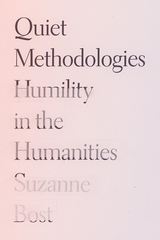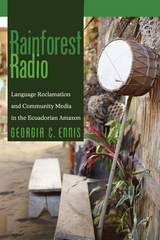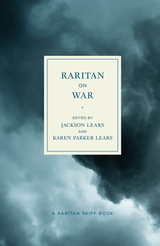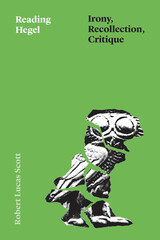3 books about Chinese Painting

The Double Screen
Medium and Representation in Chinese Painting
Wu Hung
University of Chicago Press, 1997
In the first exploration of Chinese paintings as both material products
and pictorial representations, The Double Screen shows how the
collaboration and tension between material form and image gives life to
a painting. A Chinese painting is often reduced to the image it bears;
its material form is dismissed; its intimate connection with social
activities and cultural conventions neglected.
A screen occupies a space and divides it, supplies an ideal surface for
painting, and has been a favorite pictorial image in Chinese art since
antiquity. Wu Hung undertakes a comprehensive analysis of the screen,
which can be an object, an art medium, a pictorial motif, or all three
at once. With its diverse roles, the screen has provided Chinese
painters with endless opportunities to reinvent their art.
The Double Screen provides a powerful non-Western perspective on
issues from portraiture and pictorial narrative to voyeurism,
masquerade, and political rhetoric. It will be invaluable to anyone
interested in the history of art and Asian studies.
and pictorial representations, The Double Screen shows how the
collaboration and tension between material form and image gives life to
a painting. A Chinese painting is often reduced to the image it bears;
its material form is dismissed; its intimate connection with social
activities and cultural conventions neglected.
A screen occupies a space and divides it, supplies an ideal surface for
painting, and has been a favorite pictorial image in Chinese art since
antiquity. Wu Hung undertakes a comprehensive analysis of the screen,
which can be an object, an art medium, a pictorial motif, or all three
at once. With its diverse roles, the screen has provided Chinese
painters with endless opportunities to reinvent their art.
The Double Screen provides a powerful non-Western perspective on
issues from portraiture and pictorial narrative to voyeurism,
masquerade, and political rhetoric. It will be invaluable to anyone
interested in the history of art and Asian studies.
[more]
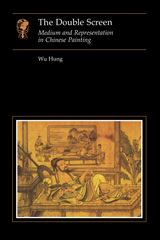
The Double Screen
Medium and Representation in Chinese Painting
Wu Hung
Reaktion Books, 1997
In the first exploration of Chinese paintings as both material products
and pictorial representations, The Double Screen shows how the
collaboration and tension between material form and image gives life to
a painting. A Chinese painting is often reduced to the image it bears;
its material form is dismissed; its intimate connection with social
activities and cultural conventions neglected.
A screen occupies a space and divides it, supplies an ideal surface for
painting, and has been a favorite pictorial image in Chinese art since
antiquity. Wu Hung undertakes a comprehensive analysis of the screen,
which can be an object, an art medium, a pictorial motif, or all three
at once. With its diverse roles, the screen has provided Chinese
painters with endless opportunities to reinvent their art.
The Double Screen provides a powerful non-Western perspective on
issues from portraiture and pictorial narrative to voyeurism,
masquerade, and political rhetoric. It will be invaluable to anyone
interested in the history of art and Asian studies.
and pictorial representations, The Double Screen shows how the
collaboration and tension between material form and image gives life to
a painting. A Chinese painting is often reduced to the image it bears;
its material form is dismissed; its intimate connection with social
activities and cultural conventions neglected.
A screen occupies a space and divides it, supplies an ideal surface for
painting, and has been a favorite pictorial image in Chinese art since
antiquity. Wu Hung undertakes a comprehensive analysis of the screen,
which can be an object, an art medium, a pictorial motif, or all three
at once. With its diverse roles, the screen has provided Chinese
painters with endless opportunities to reinvent their art.
The Double Screen provides a powerful non-Western perspective on
issues from portraiture and pictorial narrative to voyeurism,
masquerade, and political rhetoric. It will be invaluable to anyone
interested in the history of art and Asian studies.
[more]
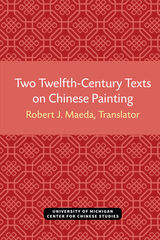
Two Twelfth-Century Texts on Chinese Painting
Robert J. Maeda, Translator
University of Michigan Press, 1970
Two Twelfth-Century Texts on Chinese Painting presents two texts in translation that provide dual insight into the Painting Academy of Emperor Hui-tsung and the literati school of painting.
The Shan-shui ch’un-ch’uan chi is a treatise for beginning landscape painters dated to the Hsüan-ho era. The treatise was written by Han Cho, a reputed member of the Academy, but the text was not specifically directed at Academicians. The treatise collects and orders previous writings on landscape painting; one of Han Cho’s main goals is to list all landscape definitions and their practical application in painting. Yet his view is more detached and analytical than a stereotypical Academy painter, revealing an approach reminiscent of Confucian scholarship and literati painting as well.
The Hua-chi by Teng Ch’un is a history of painting that was written as a sequel to two earlier painting histories. In ten chapters, Teng Ch’un compiles facts and critical evaluations of painters from 1075 to 1167, as well as listings of selected masterpieces. Teng Ch’un provides more specific information about the Academy than Han Cho, discussing its organization and examination system, and noting that “form-likeness” and adherence to rules were leading standards for painting in the Academy. On the other hand, he thinks that painting should transmit “soul,” not just “form.” Thus, Teng Ch’un writes the history of both the establishment values of the Academy and the intellectual tendencies of the literati.
[more]
READERS
Browse our collection.
PUBLISHERS
See BiblioVault's publisher services.
STUDENT SERVICES
Files for college accessibility offices.
UChicago Accessibility Resources
home | accessibility | search | about | contact us
BiblioVault ® 2001 - 2025
The University of Chicago Press



